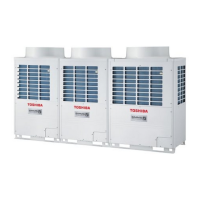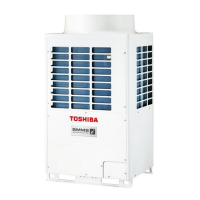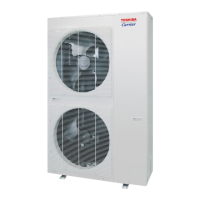What does outdoor liquid back detection error mean for my Toshiba Heat Pump?
- DDaniel BeckerJul 29, 2025
If your Toshiba Heat Pump shows an outdoor liquid back detection error, inspect for liquid refrigerant returning to the outdoor unit.

What does outdoor liquid back detection error mean for my Toshiba Heat Pump?
If your Toshiba Heat Pump shows an outdoor liquid back detection error, inspect for liquid refrigerant returning to the outdoor unit.
Explains the meaning of warning and caution symbols used in the manual.
Indicates severe risks, including death or serious injury from incorrect handling.
Indicates risks of injury or property damage from incorrect work execution.
Lists necessary tools and important handling precautions for the new refrigerant system.
Details required clearances around the outdoor unit for installation and servicing.
Instructions for installing multiple outdoor units with proper spacing and anchoring.
Guidance on setting the stool height when drawing refrigerant pipes from the bottom.
Details on how to connect the refrigerant pipes to the outdoor unit.
Illustrates pipe connection methods at the gas side valve for different models.
Specifies materials and sizing criteria for refrigerant pipes.
Provides tables for selecting appropriate pipe sizes based on capacity and connections.
Guidance on selecting pipe sizes for branching sections of the refrigerant system.
Procedure for performing an airtight test on the refrigerant piping system.
Steps for purging air from the refrigerant pipes using a vacuum pump.
Calculation and procedure for adding refrigerant to the system.
Instructions on how to fully open the valves on the outdoor unit.
Guidance on applying thermal insulation to refrigerant pipes.
Emphasizes qualified electrician, exclusive circuits, and risks of fire/shock.
Warns against combustible gas locations and the need for earth leakage breakers.
Details power supply requirements and fuse specifications for outdoor units.
Specifies wiring types, sizes, and quantities for various control connections.
Illustrates the system's control wiring diagram and specifications.
Provides cable specifications and connection diagrams for controlling the units.
Details power supply wiring and fuse specifications for combined outdoor unit configurations.
Specifies power supply wiring requirements for indoor units.
Explains how to operate multiple indoor units in a group using a single remote controller.
Illustrates the overall system wiring, including power and control connections.
Summarizes connection details between indoor and outdoor units.
Details how to connect power supply and control cables to the outdoor unit.
Procedure for automatically setting addresses for indoor and outdoor units.
Manual address setup procedure using DIP switches on the header unit's P.C. board.
Details switch settings for manual address setup, especially for central control.
Step-by-step guide for setting addresses using the wired remote controller.
Instructions for confirming indoor unit addresses and their positions via the remote controller.
Procedures to check indoor unit numbers and positions in group or individual operation.
Method for changing indoor unit addresses using the wired remote controller after initial setup.
Instructions for changing all indoor addresses remotely for each refrigerant line.
Procedure to reset addresses to factory default via remote or outdoor unit.
Pre-checks required before performing the test operation.
Detailed steps for performing a test operation using the wired remote controller.
Instructions for performing test operations via switches on the header unit's interface P.C. board.
Explains how to interpret segment displays and check codes on the outdoor unit.
Lists and explains check codes displayed on the outdoor unit for troubleshooting.












